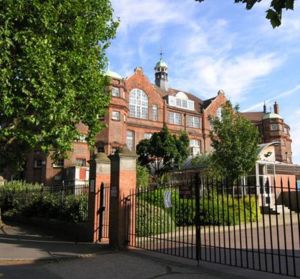Leaman Grove School: Difference between revisions
Morgan Blair (talk | contribs) (Added DangerReport inclusion.) |
No edit summary |
||
| Line 15: | Line 15: | ||
==Leaman Grove School== | ==Leaman Grove School== | ||
===Description=== | ===Description=== | ||
[[Image:School-9723.jpg|thumb|left|300px|Leaman Grove: crucible of learning.]] | |||
A red-brick Victorian school topped by a cupola, from which the smoking ruins of Malton can be surveyed. | |||
===History=== | |||
Founded by philanthropic spinster Phyllis McWhirter in 1815 for maimed drummer boys returning from the Battle of Waterloo, Leaman Grove soon established a reputation for academic vigour and iron discipline. Inured by their battlefield experiences, the pupils thought nothing of the brutal floggings dished out for minor infractions, such as blotting one's Latin primer or omitting to tie one's cravat correctly. | |||
However, the horror of the school's gruel remained etched on their memories ever after: graffiti about its repulsive flavour, rumoured ingredients and watery texture can be seen to this day, scratched into the surviving walls of the building among the bloodstains. | |||
The school's brightest ''alumni'' were Willard Whitlock, William Whitehead and Walfrid Warburton, who developed the ''Walloper'' steam locomotive and helped to prompt the railway's spread across Malton. Whitlock is memorialised at the [[Whitlock Way Railway Station|neighbouring railway station]], while his partners are buried in Pegton's northern [[Cemetery 82,51|cemetery]]. | |||
===Barricade Policy=== | ===Barricade Policy=== | ||
===Current Status=== | ===Current Status=== | ||
'''''For Future Help, recording a date to the building status is recommended.''''' | |||
'''10 July, 2007''': Unknown at this time. --[[User:Bono Landy|Bono Landy]] 17:28, 10 July 2007 (BST) | '''10 July, 2007''': Unknown at this time. --[[User:Bono Landy|Bono Landy]] 17:28, 10 July 2007 (BST) | ||
Revision as of 15:52, 6 December 2009
| Leaman Grove School |
| Leaman Grove School
Pegton [80, 59] Basic Info:
|
Leaman Grove School
Description
A red-brick Victorian school topped by a cupola, from which the smoking ruins of Malton can be surveyed.
History
Founded by philanthropic spinster Phyllis McWhirter in 1815 for maimed drummer boys returning from the Battle of Waterloo, Leaman Grove soon established a reputation for academic vigour and iron discipline. Inured by their battlefield experiences, the pupils thought nothing of the brutal floggings dished out for minor infractions, such as blotting one's Latin primer or omitting to tie one's cravat correctly.
However, the horror of the school's gruel remained etched on their memories ever after: graffiti about its repulsive flavour, rumoured ingredients and watery texture can be seen to this day, scratched into the surviving walls of the building among the bloodstains.
The school's brightest alumni were Willard Whitlock, William Whitehead and Walfrid Warburton, who developed the Walloper steam locomotive and helped to prompt the railway's spread across Malton. Whitlock is memorialised at the neighbouring railway station, while his partners are buried in Pegton's northern cemetery.
Barricade Policy
Current Status
For Future Help, recording a date to the building status is recommended.
10 July, 2007: Unknown at this time. --Bono Landy 17:28, 10 July 2007 (BST)
| This page, Leaman Grove School, is a locations stub. Please help us to improve the wiki by contributing to this page. Be sure the following information is added to the page: coordinates, suburb, 9 block map (or 16 block map for large buildings), description, barricading policy, and history. Please refer to the Location Style Guide. |
